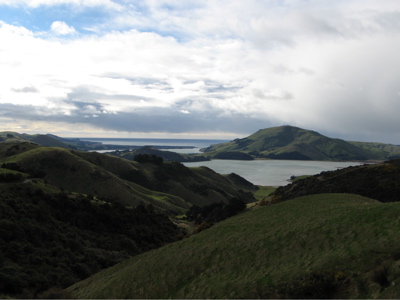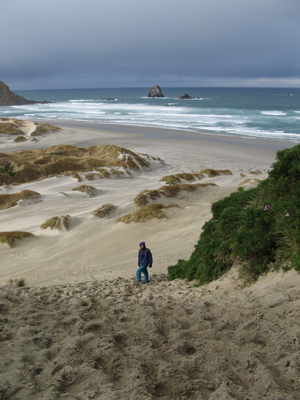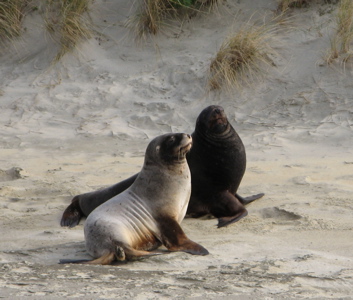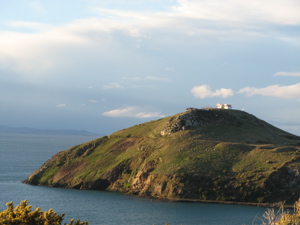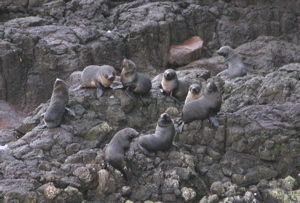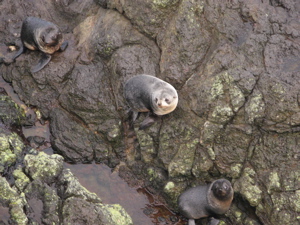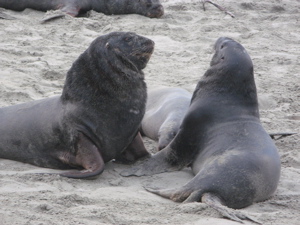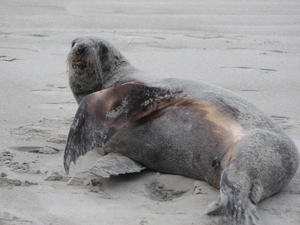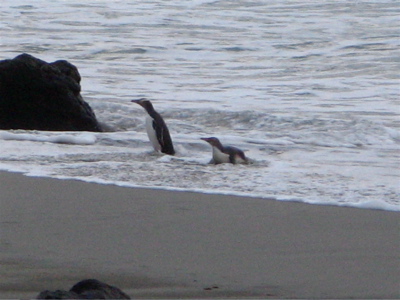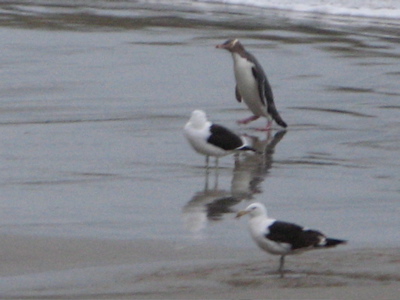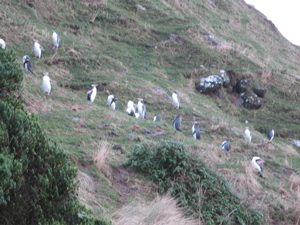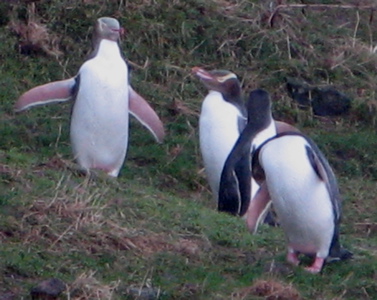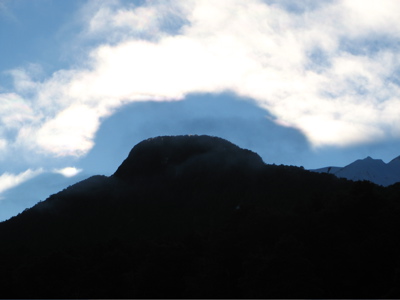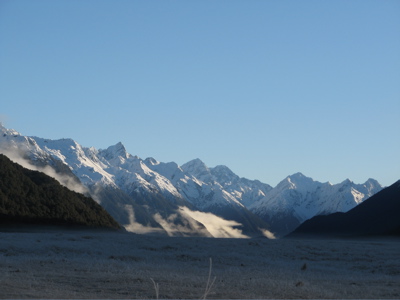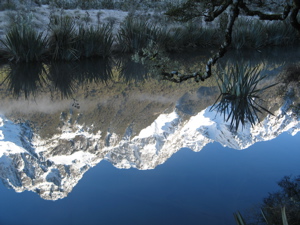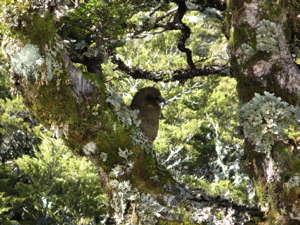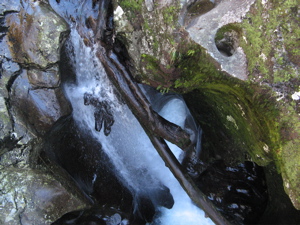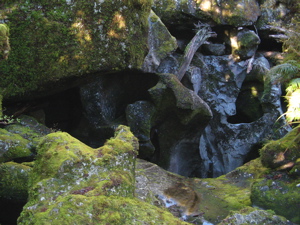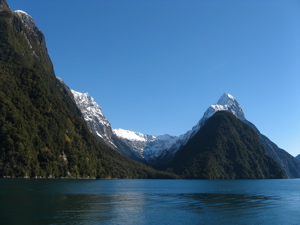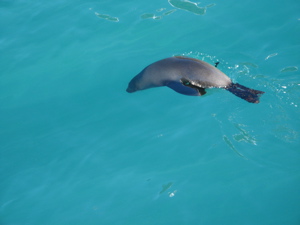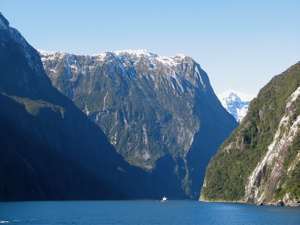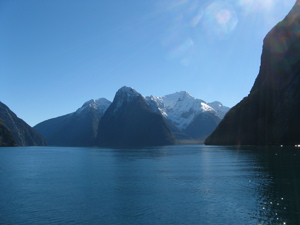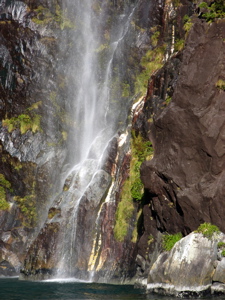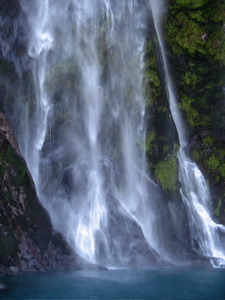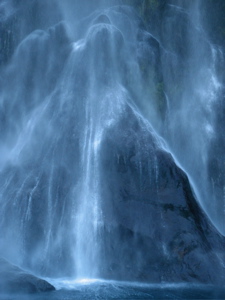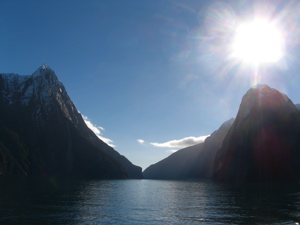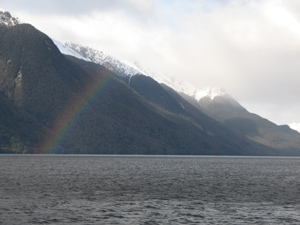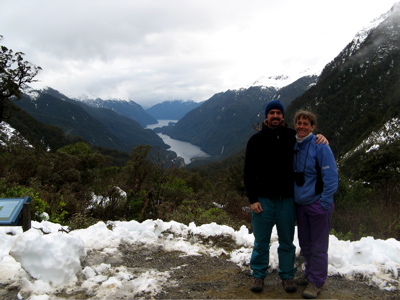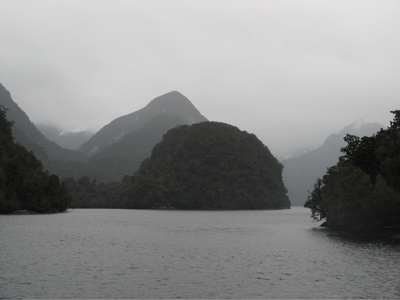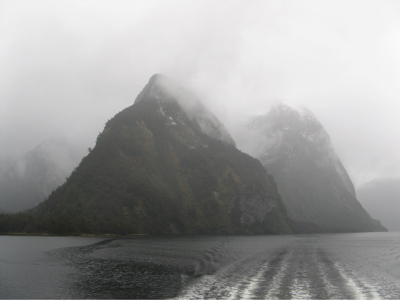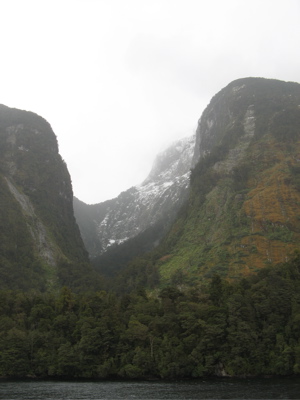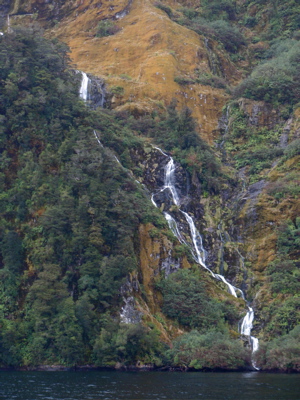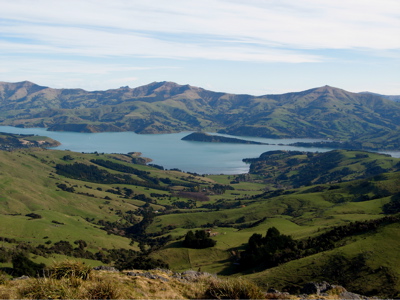Although
it was sunny
when we left Te
Anau, as you can see, the skies became filled with rain (and rainbows)
as we crossed the lake. We passed the Cathedral Peaks
(reaching
5000 feet) and the thirty-some islands in the lake. The rest
of
the day
was grey and rainy
and wonderful. We stayed warm and relatively dry with our
rain
gear (and hats, gloves, scarves and long undies!) and with the free tea
and hot chocolate available on the boat. Good thing, too,
because
we couldn't keep ourselves indoors; it was too beautiful.
There
were points where it was too windy (like when we went out into the
Tasman Sea and saw a colony of fur seals hanging out on a some rocks)
or wet to go to the top deck, but we
were able to stay outside on the middle deck for most of the
afternoon.
Again, it's hard to give
you a perspective on how large these
cliffs are; remember, those are full sized trees along the shore.
One of the peaks along the shore (Commander Peak) is about
5,000 ft.
high, And of course, it's even harder to capture the beauty
of this
place because of the lighting and the wet conditions, but trust us,
this place is
spectacular.
As always, our guides,
including the bus
drivers, were informative, friendly and very funny!
But we
had an extra-special treat on this day. The captain was going
extra slowly through "Hall Arm" (above two photos) and informed us that
it was not because they saw animals for us to view, but because it was
just so spectacular to look at that day. We agreed, and were
grateful for the extra viewing time. When we got to the end
of
this "finger" of the sound (it had been closed off from the rest of the
sound by a small earthquake years before) and had to turn around, the
captain asked everyone to stop talking. walking and clicking pictures
and to just stand in silence for a few minutes as they turned off all
the engines and generators so that we could appreciate the place in
silence. A memorable few minutes, with the lapping of the
waves
and the birds' calls "breaking" the silence in the most peaceful and
wonderful way imaginable.
On the way back the bus
stopped at the
Manapouri underground
hydroelectric power station. We felt a bit claustrophobic
driving
over a mile down a sprial tunnel into the plant. It was hard
to
imagine the life of the folks who built this thing (in the early
1960s), even when you see the photos. It is a fairly good
balance
with the environment considering its size/power. There is
enough
of a differential in the levels of the lake and the sound that a dam
was not necessary, and you don't see
very much of it.
We were frustrated by our limited time to do all that we wanted to do
and see all that we wanted to see (no, we don't expect sympathy from
any of you). At this point, we had to make a
choice: Do we try to drive up the west coast and see the
glaciers or
head more directly to Mt. Cook? In the end we decided it
would be too
much driving (and too risky to assume that all the roads would remain
open for the next few days) to see the glaciers. No regrets
about our
choices, but it does mean that we will need to go back to New Zealand
at
least
once more!
Aoraki/Mt.
Cook National Park
As we were driving toward Mt. Cook in the Southern Alps, we had
many spectacular
views of snow covered peaks. We kept trying to figure out
which
one was Mt. Cook. Elyse wouldn't believe Gerald at first when
he
said we couldn't even see it in the view from the end of the lake
(below, left).
How does one hide a 12,000 foot mountain? But it
was true.
It wasn't until we took a (spectacular) hike in along Hooker
Valley that we saw Mt. Cook (below, right). At this
stage in the hike we were actually surrounded by peaks. It
was
difficult to
decide which view was the most awesome.
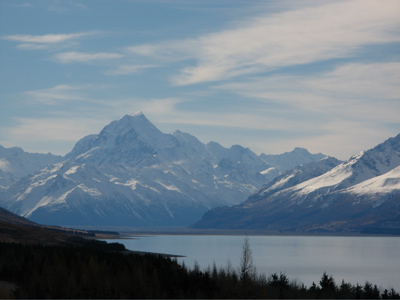
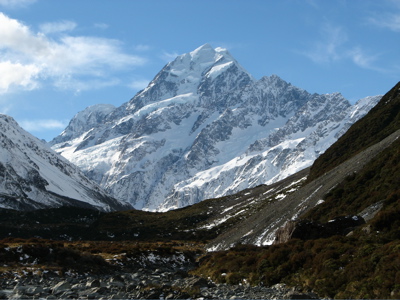
To get to this part of the valley, we had to cross two swing bridges
(see Gerald below on one of them). Elyse's
strategy for getting across was to walk as quickly
as possible, not to look down and to hold on to the rails as tightly as
possible. On the way back (despite the increased wind and,
therefore, movement of the bridge) she was actually able to sneak a
peak at the blue-green, cloudy water below. Stunning.
It was quite windy, so the sky/cloud formations were changing as we
walked (2 1/2 hours or so) and we kept stopping to gape at the scenes
around us. At one point we heard what sounded like an
avalanche
(NOT what one wants to hear when in a valley surrounded by snow-covered
mountains!). We finally found the source through our
binoculars
and saw that there were 1/2 dozen rocks (okay, they were probably
boulders) falling down the side of one of the mountains down the
valley. It reinforced to us how loud (and powerful) a real
avalanche must be! Shortly after we heard what sounded like
thunder. We turned (thinking that the weather was changing
faster
than we had thought) and saw that a huge chunk of snow had fallen off
near the frozen waterfall pictured below. It was loud and
another
reminder of nature's power. We weren't sure how long we
would
have light after the sun went behind the mountains, so we headed back.
We stopped at the village for a drink and alternated between
sitting in front of the fire and soaking in the view of the mountains.
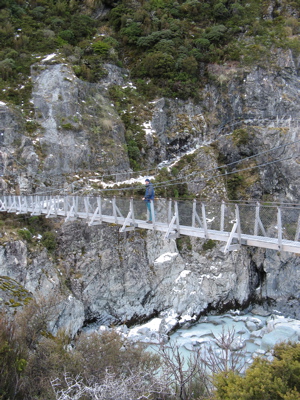
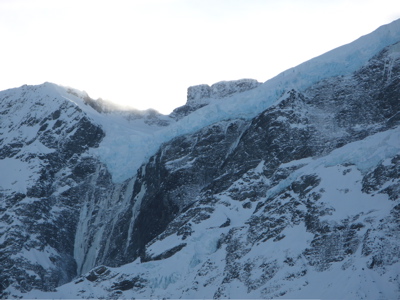
Our plan was to do another
long hike in
the morning before continuing on. We started out (from the
town
we were staying in near the park) early as there were
forecasts
for showers in the afternoon. When we got close to the
park and were driving along the (azure-blue) Lake Pukaki, it
was
hard to keep the car going in a straight line because of the wind gusts
that kept hitting us. We decided that a shorter walk might be
a
safer choice. Good thing, too! It was hard enough
to manage
that! We had to brace ourselves at times to keep from being
blown
over - or along. It was just the wrong side of fun, but still
worth the effort. By the time we were back at the car, clouds
were covering the peaks and building up behind the mountains, so we got
a move on. You can see the color of the lake and the winds
"playing" on the water below. It was stunning (and hard work
until we had cleared the lake and had some trees blocking the wind).
Does this lake look familiar to any of you?
According to
the tourist office it was used in Lord of the Rings (we have to rewatch
them to see what we recognize)....
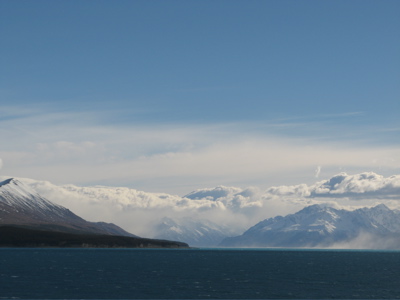
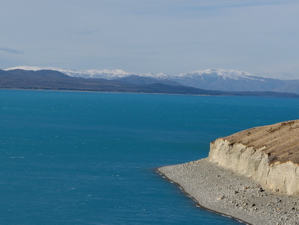
Banks Peninsula and Akaroa
We had decided to drive next to Banks Peninsula, which juts out from
near Christchurch (from where we were flying to Oz). It was a
long day's drive (especially given the windy beginning), but as we
wound our way up and down the road ("wound" being the operative
word...the road was so windy that we had to open the windows to help
some severe car-sickness!) we knew it was worth it. The area
was
formed from volcanic eruptions that created tall, "folded" hills and
lots of bays and inlets. As you can see above, it is
beautiful,
especially with a blue sky and bright sun.
Apparently, Akaroa was settled by the French (the British declared
"ownership" of New Zealand just four days before the French arrived in
Akaroa), so there
is a French "feel" to the place (including having all the streets
called Rue...) When we were settled into our room (with a
balcony
overlooking the water), we walked through town and along the shore. It
was warm enough for a t-shirt! Quite a shock after having so
many
layers on for the walk at Mt. Cook that morning. We were
extra
lucky to have a spectacular sunset. We wish we could share the sounds
of the birds as we stood by the lighthouse watching it. We
then
had a delicious meal by a roaring fire and then a walk under the stars.
A great way to end the day... and a nice, relaxing and
rejuvenating last stop on our trip.
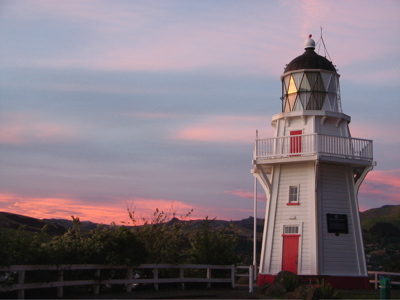
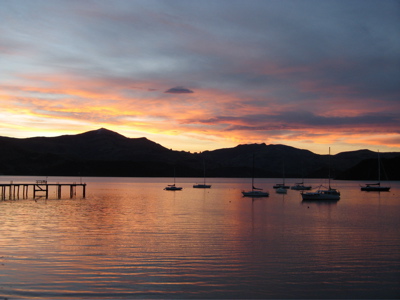
We awoke to another
beautiful day and
took another walk around town before heading out to do some local hikes
in the hills. We saw another example of New Zealander humor
with
this bungy-jumping rag doll at a local backpackers' hotel called Le Bon
Accord. It brought back disturbing memories of Elyse's
viewing of
a real bungy-jumper (Gerald was driving) at the "original" site for
bungy-jumping. Yikes! NZ seems to be a mecca for
adventurers - or death-defying maniacs!
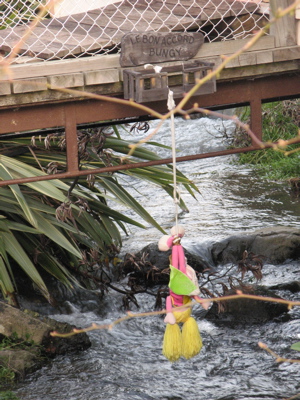
We headed out for some
hiking after
a "Hokey Pokey" ice cream cone for Elyse (we couldn't leave the country
without her experiencing NZ ice cream now, could we?). The
first
hike was
a bit rough, but afforded us a great lunch spot with great views of
Akaroa and the harbors on one side and the ocean on the other.
The second one also had its steep, slippery bits, but the
trees
were stunning. They had rust and red bark and were often
twisted
in all sorts of interesting ways. Again, we had some
beautiful
views from the top and a surprise on our way down the other part of the
loop: a cow must have crossed the fence at the top and found
his/her way down the trail. There were hoof prints and poop
piles
lining the track. It was hard enough to do as a human, but a
cow
would have really
struggled! Our last hike was a short one just to see this
tree
which is estimated to be 1000 years old. It is about 25 feet
in
diameter and looking pretty good considering its age!
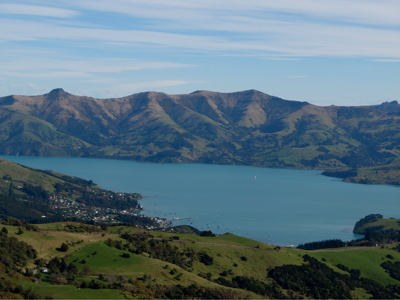
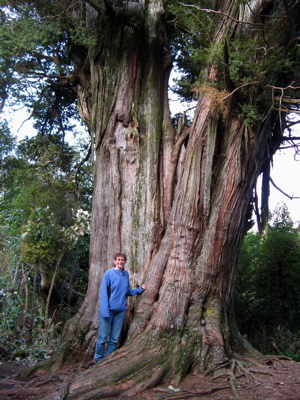
Christchurch
and Oz
We drove to Christchurch next. It was a pretty ride and had a
little extra perk in that there was a parade of university students in
cars they had decorated in various ways. There were about 100
of
them in cars (and costumes) ranging from a Trojan horse (and warriors)
to a police car. It was hysterical to see. We
walked around
Christchurch a bit (nice as it is, we were glad that we hadn't spent
our 2 weeks in any
cities) before looking for a place for dinner. New Zealand
was
playing Australia in a rugby match and we couldn't find anywhere
without a big screen TV showing it! Gerald had Elyse doing
the
ordering at the restaurant just in case they recognized the accent!
We headed back to the hotel early as we had to get up at 3:15
a.m. to catch our flight to Adelaide. As wonderful as this
trip
was, we were also very much looking forward to seeing everyone in
Adelaide, so it made the end less traumatic.
We would be hard pressed to choose a favorite part of this trip.
We were extremely lucky with the weather and managed to see a
lot
without feeling rushed or tired. The Kiwis (New Zealanders)
enhanced every experience with their warmth and humor. On our
flight to Australia, the guy (Kiwi) sitting next to us was looking at
our pictures with us (we were culling) and relating stories of his
travels and adventures in New Zealand. He insisted that we
have
to see everything at least twice - in summer and winter - and praised
many parts we didn't have a chance to see this time around.
Guess we'll have to go back.... Twist our arms.
